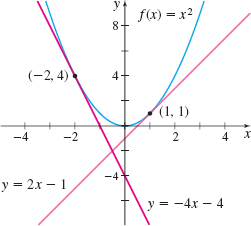EXAMPLE 3Finding an Equation of the Tangent Line to the Graph of f(x)=x2
- (a) Find the slope of the tangent line to the graph of f(x)=x2 at c=1 and at c= −2.
- (b) Use the results from (a) to find an equation of the tangent lines when c=1 and c=−2.
- (c) Graph f and the two tangent lines on the same set of axes.
Solution
(a) At c=1, the slope of the tangent line is f′(1)=lim
At c=-2, the slope of the tangent line is \begin{eqnarray*} f^\prime ( -2) &=&\lim\limits_{x\rightarrow -2}\dfrac{ f( x) -f( -2) }{x-(-2)}=\lim\limits_{x\rightarrow -2} \dfrac{x^{2}-( -2) ^{2}}{x+2}=\lim\limits_{x\rightarrow -2}\dfrac{ x^{2}-4}{x+2}\\[11pt] &=&\lim\limits_{x\rightarrow -2}( x-2) =-4 \end{eqnarray*}
The point-slope form of a line is discussed in Appendix A.3, p. A-18.
(b) We use the results from (a) and the point-slope form of an equation of a line to obtain equations of the tangent lines. An equation of the tangent line containing the point (1, f(1)) =(1,1) is \begin{eqnarray*} \begin{array}{rl@{\qquad}l} y-f(1) &= f^\prime (1) ( x-1) & {\color{#0066A7}{\hbox{Point-slope form of an equation of the tangent line.}}}\\[5pt] y-1 &= 2( x-1) & {\color{#0066A7}{\hbox{\(f(1) = 1;\quad f^\prime(1) =2.\)}}} \\[5pt] y &= 2x-1 & {\color{#0066A7}{\hbox{Simplify.}}} \end{array} \end{eqnarray*}
149
An equation of the tangent line containing the point ( -2, f( -2)) =(-2,4) is \begin{eqnarray*} \begin{array}{rl@{\qquad}l} y-f( -2) &= f^\prime ( -2) [x-( -2)] \\[5pt] y-4 &=-4\cdot (x+2) & {\color{#0066A7}{\hbox{\(f(-2) = 4; \quad f^\prime (-2) =-4\)}}} \\[5pt] y &=-4x-4 \end{array} \end{eqnarray*}
(c) The graph of f and the two tangent lines are shown in Figure 5.
